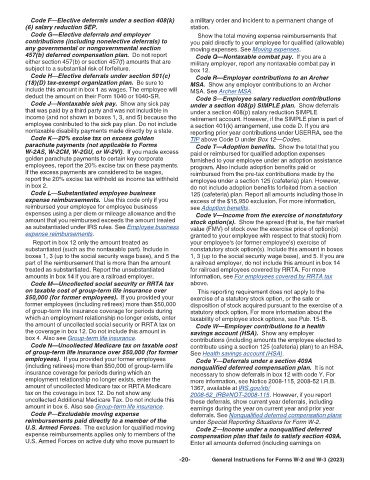Page 439 - Individual Forms & Instructions Guide
P. 439
14:39 - 29-Dec-2022
Page 20 of 34
Fileid: … iw-2-&-w-3/2023/a/xml/cycle04/source
The type and rule above prints on all proofs including departmental reproduction proofs. MUST be removed before printing.
Code F—Elective deferrals under a section 408(k) a military order and incident to a permanent change of
(6) salary reduction SEP. station.
Code G—Elective deferrals and employer Show the total moving expense reimbursements that
contributions (including nonelective deferrals) to you paid directly to your employee for qualified (allowable)
any governmental or nongovernmental section moving expenses. See Moving expenses.
457(b) deferred compensation plan. Do not report Code Q—Nontaxable combat pay. If you are a
either section 457(b) or section 457(f) amounts that are military employer, report any nontaxable combat pay in
subject to a substantial risk of forfeiture. box 12.
Code H—Elective deferrals under section 501(c) Code R—Employer contributions to an Archer
(18)(D) tax-exempt organization plan. Be sure to MSA. Show any employer contributions to an Archer
include this amount in box 1 as wages. The employee will MSA. See Archer MSA.
deduct the amount on their Form 1040 or 1040-SR. Code S—Employee salary reduction contributions
Code J—Nontaxable sick pay. Show any sick pay under a section 408(p) SIMPLE plan. Show deferrals
that was paid by a third party and was not includible in under a section 408(p) salary reduction SIMPLE
income (and not shown in boxes 1, 3, and 5) because the retirement account. However, if the SIMPLE plan is part of
employee contributed to the sick pay plan. Do not include a section 401(k) arrangement, use code D. If you are
nontaxable disability payments made directly by a state. reporting prior year contributions under USERRA, see the
Code K—20% excise tax on excess golden TIP above Code D under Box 12—Codes.
parachute payments (not applicable to Forms Code T—Adoption benefits. Show the total that you
W-2AS, W-2CM, W-2GU, or W-2VI). If you made excess paid or reimbursed for qualified adoption expenses
golden parachute payments to certain key corporate furnished to your employee under an adoption assistance
employees, report the 20% excise tax on these payments. program. Also include adoption benefits paid or
If the excess payments are considered to be wages, reimbursed from the pre-tax contributions made by the
report the 20% excise tax withheld as income tax withheld employee under a section 125 (cafeteria) plan. However,
in box 2. do not include adoption benefits forfeited from a section
Code L—Substantiated employee business 125 (cafeteria) plan. Report all amounts including those in
expense reimbursements. Use this code only if you excess of the $15,950 exclusion. For more information,
reimbursed your employee for employee business see Adoption benefits.
expenses using a per diem or mileage allowance and the Code V—Income from the exercise of nonstatutory
amount that you reimbursed exceeds the amount treated stock option(s). Show the spread (that is, the fair market
as substantiated under IRS rules. See Employee business value (FMV) of stock over the exercise price of option(s)
expense reimbursements. granted to your employee with respect to that stock) from
Report in box 12 only the amount treated as your employee's (or former employee's) exercise of
substantiated (such as the nontaxable part). Include in nonstatutory stock option(s). Include this amount in boxes
boxes 1, 3 (up to the social security wage base), and 5 the 1, 3 (up to the social security wage base), and 5. If you are
part of the reimbursement that is more than the amount a railroad employer, do not include this amount in box 14
treated as substantiated. Report the unsubstantiated for railroad employees covered by RRTA. For more
amounts in box 14 if you are a railroad employer. information, see For employees covered by RRTA tax
Code M—Uncollected social security or RRTA tax above.
on taxable cost of group-term life insurance over This reporting requirement does not apply to the
$50,000 (for former employees). If you provided your exercise of a statutory stock option, or the sale or
former employees (including retirees) more than $50,000 disposition of stock acquired pursuant to the exercise of a
of group-term life insurance coverage for periods during statutory stock option. For more information about the
which an employment relationship no longer exists, enter taxability of employee stock options, see Pub. 15-B.
the amount of uncollected social security or RRTA tax on Code W—Employer contributions to a health
the coverage in box 12. Do not include this amount in savings account (HSA). Show any employer
box 4. Also see Group-term life insurance. contributions (including amounts the employee elected to
Code N—Uncollected Medicare tax on taxable cost contribute using a section 125 (cafeteria) plan) to an HSA.
of group-term life insurance over $50,000 (for former See Health savings account (HSA).
employees). If you provided your former employees Code Y—Deferrals under a section 409A
(including retirees) more than $50,000 of group-term life nonqualified deferred compensation plan. It is not
insurance coverage for periods during which an necessary to show deferrals in box 12 with code Y. For
employment relationship no longer exists, enter the more information, see Notice 2008-115, 2008-52 I.R.B.
amount of uncollected Medicare tax or RRTA Medicare 1367, available at IRS.gov/irb/
tax on the coverage in box 12. Do not show any 2008-52_IRB#NOT-2008-115. However, if you report
uncollected Additional Medicare Tax. Do not include this these deferrals, show current year deferrals, including
amount in box 6. Also see Group-term life insurance. earnings during the year on current year and prior year
Code P—Excludable moving expense deferrals. See Nonqualified deferred compensation plans
reimbursements paid directly to a member of the under Special Reporting Situations for Form W-2.
U.S. Armed Forces. The exclusion for qualified moving Code Z—Income under a nonqualified deferred
expense reimbursements applies only to members of the compensation plan that fails to satisfy section 409A.
U.S. Armed Forces on active duty who move pursuant to Enter all amounts deferred (including earnings on
-20- General Instructions for Forms W-2 and W-3 (2023)

